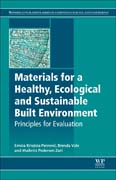
Principles for Evaluating Building Materials in Sustainable Construction: Healthy and Sustainable Materials for the Built Environment
Petrovic, Emina
Zari, Maibritt Pedersen
Vale, Brenda
This book provides a comprehensive overview of the issues associated with the selection of materials for sustainable construction and proposes a holistic and integrated approach. It evaluates the issues involved in choosing materials from an ecosystem services perspective, through the process of the design stage to the impact of materials on the health of building users. The core aim of the book is that none of these aspects should be considered in isolation, but rather that a full evaluation of the appropriateness of a material for sustainable construction requires engagement at all these levels. The three main sections of the book discuss building materials in relation to ecosystem services, the implications of materials choice at the design stage, and impact of materials on building users and their health. The final section then focuses on specific case studies illustrating these principles. The historical case studies illustrate the richness of solutions that existed before the rise of contemporary construction and that are consistent with a sustainable approach to creating built environments. These are followed by modern examples which apply some, if not all, of the principles discussed in the first three sections of the book. Provides a thorough understanding of ecosystem services based on ecology research and shows how this can be linked more explicitly and practically with built environment design and used in a quantifiable wayProposes principles for the evaluation and appropriateness of building and furnishing materials for sustainable constructionCase studies illustrating principles that are consistent with a sustainable approach to creating built environments INDICE: 1. Introduction Section 1: Building materials in relation to ecosystem services 2. Ecosystem services and materials used in the built environment - current situation 3. Ecosystem service provision as a criterion for materials selection Section 2: The implications of materials choice at the design stage 4. Material types 5. Life cycle assessment (LCA) 6. Waste from design and construction Section 3: Impact of materials on building users and their health 7. Issues associated with existing processes for recognition of health risks 8. Lead and asbestos - the best known hazards 9. Formaldehyde and phthalate plasticisers in PVC and vinyl - currently under discussion for elimination 10. On-going suspicion, such as VOCs from carpets, nanotechnology, and new replacement materials - not very recognized risks, but some concerns raised Section 4: Case Studies 11.Palm thatched building in West Coast Mexico 12. Traditional European approach to materials in Serbia 13. The effect of global trade on the New Zealand house 14. Examples of projects focused on re-using materials and associated issues 15. Designing for low life-cycle impact buildings 16. Issues facing contemporary architectural practice aspiring to integrate a sustainable approach 17. Conclusions
- ISBN: 978-0-08-100707-5
- Editorial: Woodhead Publishing
- Encuadernacion: Cartoné
- Páginas: 448
- Fecha Publicación: 01/04/2017
- Nº Volúmenes: 1
- Idioma: Inglés
